In this edition of Breaking The Scene we head over to Finland and dissect a pivoting scene from Matias Raassina’s Vain Me Kaksi (The Two of Us). The film is about a young couple, who are on the turning point of their relationship. Bursting on paranoia the man ends up finding himself in a situation he didn’t want to be in. The pivoting scene happens about one third into the film, between 11:45 and 13:28 at a crucial moment. A moment where the film’s abstract elements start to unfold.
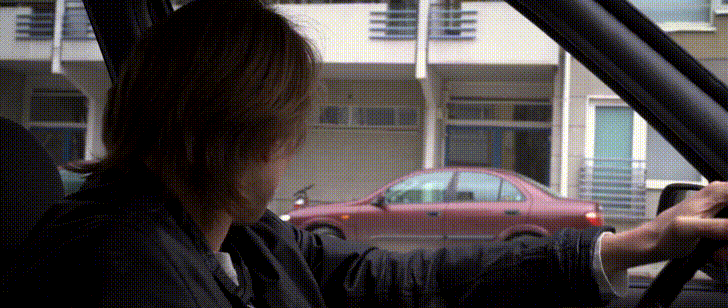
Breaking it down
The scene starts with a view of the driver through the passenger’s rear view mirror from outside the car. The camera then swerves in through the window inside the car across the passenger and driver seat out the driver’s window. Once back through the outside the camera turns 180 degrees to frame the driver looking out the side window. To close off the scene the camera harmoniously tilts towards the sky to rotate to a transitioning night sky back down towards the car. Let’s check in with the director to help us break down the scene.
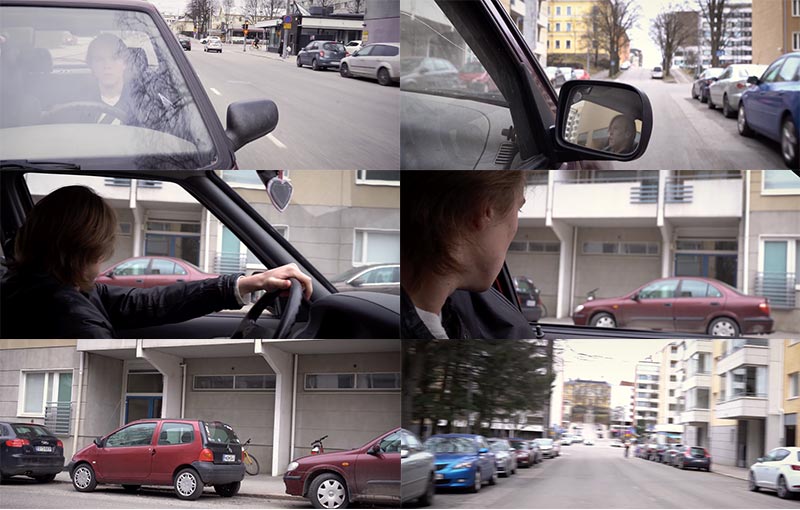
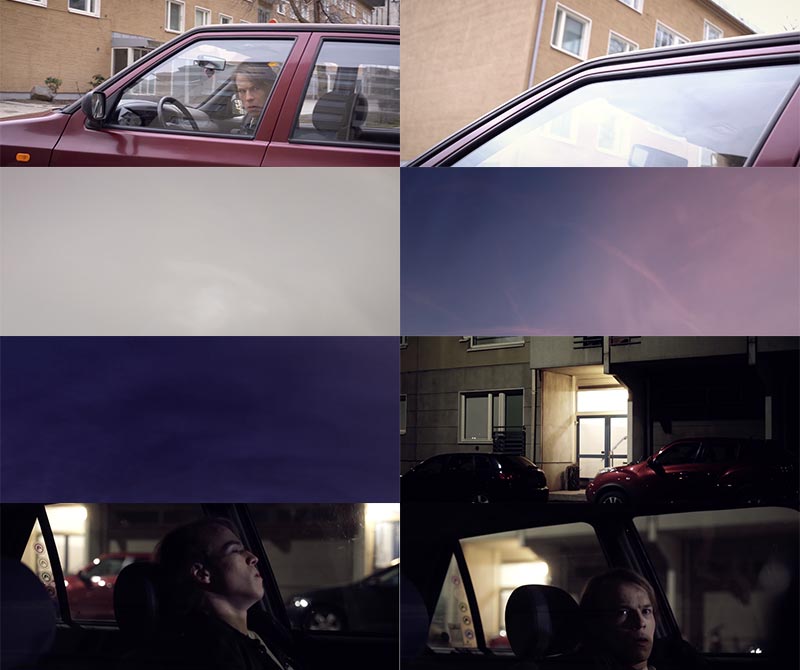
Can you tell us what the intentions you had from this scene, and why go with such a challenging shot?
Matias: As I was planning the shot list I quite soon realized that this is the turning point in the screenplay when we slowly start to reveal the story’s more surreal and psychologically abstract ideas. We wanted to convey this in a visual manner that wasn’t heavily relying on traditional editing, music or dialogue. I started to come up with ideas that could indicate this, but still stay true to the language of the film. During this process I came up with the idea of going through the car and fading to the night scene in a single take to give the audience a subconscious suggestion that things are taking a turn. I also wanted to sustain the dreamlike quality from the scene prior, where Mikael, our protagonist, is having a nightmare. Hence the slow and dreamlike pacing of the scene.
It was never really about “Let’s do a challenging shot!”, but rather let’s do a shot which conveys the story in a visual manner. I feel when filmmaking is approached with this mindset, the scenes tend to be challenging to achieve. For me that’s what intrigues me in visual storytelling, I would not be interested in something that’s generic, easy and formal.
Do you have a specific inspiration for this shot? Where did the idea come from?
Matias: I would say the particular shot is quite heavily inspired by the Mexican masters Alfonso Cuarón and Alejandro González Iñárritu and more specifically their work on films like Children of Men and The Revenant.
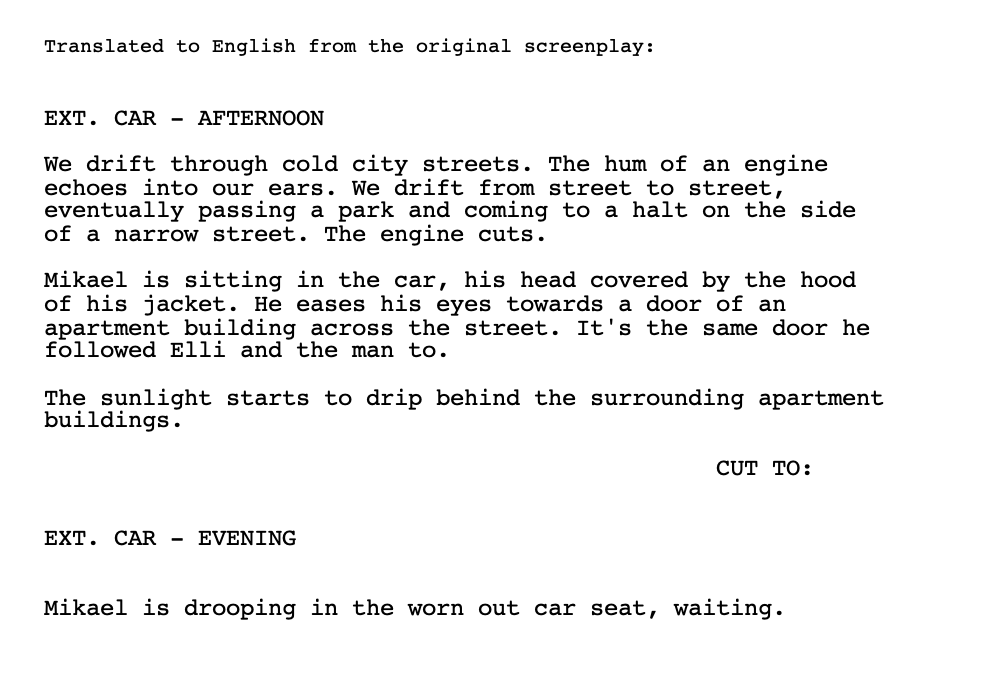
Tell us how you choreographed the entire scene, from script, storyboarding to preparation.
Matias: I always felt that in the screenplay I never really nailed the scene since there wasn’t any indication to the reader that things are taking a turn in the narrative. So when it was time to plan the shot I knew that it would be hard to describe what I wanted, so I decided to do a little pre-visualization that I showed to the cinematographer Daniel. Since he is an ambitious person he was on board with the idea of an ambitious shot from the get go.
We soon realised that we might be able to pull it off with our equipment since our camera (Sony A7 III) is physically quite small and light. We attached the camera and the stabilizer gimbal to a monopod and started to test the shot together without the actor. After a few tests we decided to go with the shot since they were successful. As we prepared principal photography we showed all our tests to our actor Julius and went through the whole shot with him.
Take us through the scene from the cameraman’s point of view. How many we’re there? Where did they sit or stand?
Matias: On the day of the shoot we had a very limited time frame of two hours to do the shot due to our actor’s availability. We rehearsed the shot with our actor and did a couple dry runs without the car moving. Daniel was sitting on the backseat holding the monopod out of the window. As the car started backing up into the parking spot I grabbed the monopod and pushed the camera through the car. Meanwhile Daniel got out of the backseat and ran to the other side of the car. Just as the camera’s field of view went past our actor Julius, he helped to support the monopod and passed it onto Daniel who did the pan outside the car.
As the camera looked at the apartment building across the street, Julius rolled up the window and I hid behind the car. As the camera looked up at the sky that was where the first part of the shot ended. It took us seven takes to get it and we ended up using the fifth one. The take we ended up using had a major flaw in the part where the camera is looking at the apartment building. The shot lingered and shook way too much, but by some miracle a car passed by the frame as we were coming through the window, so we were able to do a hidden cut there.
The second part of the shot during the night was a fairly simple pan from the night sky to Julius. I stitched these two takes together with fading HDRI skies which was achieved with Blender 3D and composited with the shot footage with Adobe After Effects. I also added the car windows and reflections with After Effects during the first part of the shot.
So basically the shot was achieved in two hours using my friend’s twenty year old crappy car, a monopod bought off of Amazon, an old PC and three passionate filmmakers.
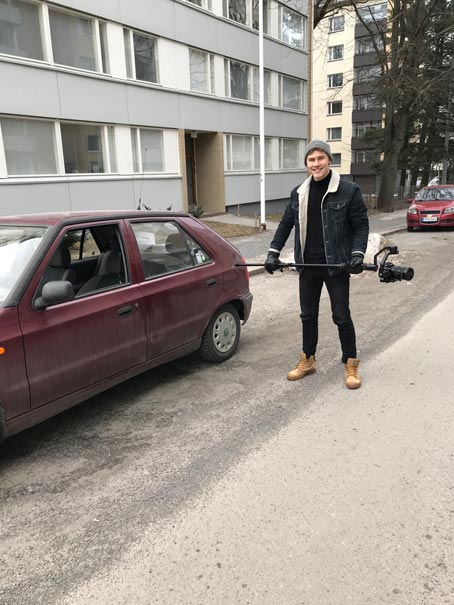
If you had a dedicated budget, what would you do differently?
Matias: The first thing that we should acknowledge is the fact that if we had a dedicated budget we would not be shooting with a Sony A7. We would be shooting with a cinema camera which would not be able to be attached to an aluminum stick. So we probably would have to go with a similar kind of rig as they did in Children of Men’s famous car scene. This approach would get rid of the camera shake that is evident in our shot. I would also get rid of the car in front of the apartment building door. I’m fairly happy with what we achieved since to me equipment is secondary and the lack of it is only an excuse not to achieve the initial vision.
Thank you so much for your time Matias, your work is inspirational. We hope this insight provides helpful hints to aspiring filmmakers with limited budgets. We already look forward to your next film!
You can watch Matias’ films Vain Me Kaksi (The Two of Us) and Virtaus right here on Film Shortage.

